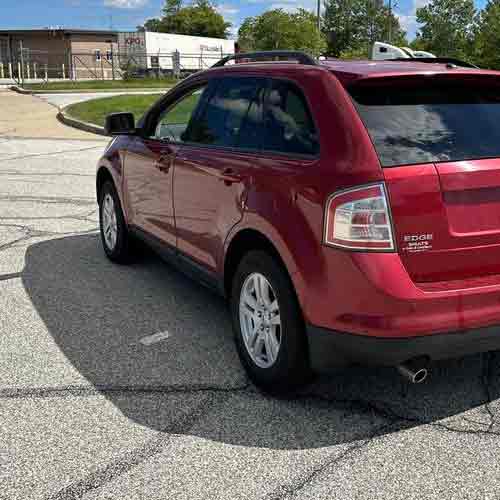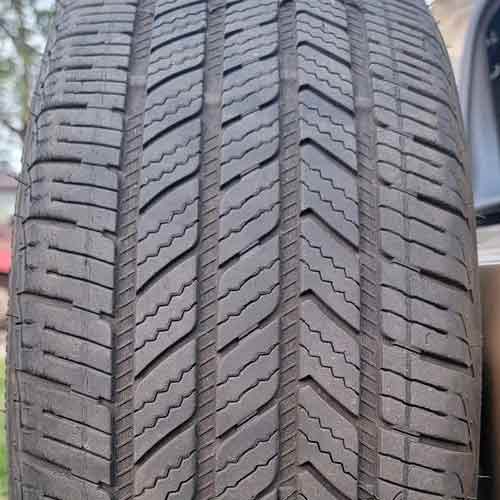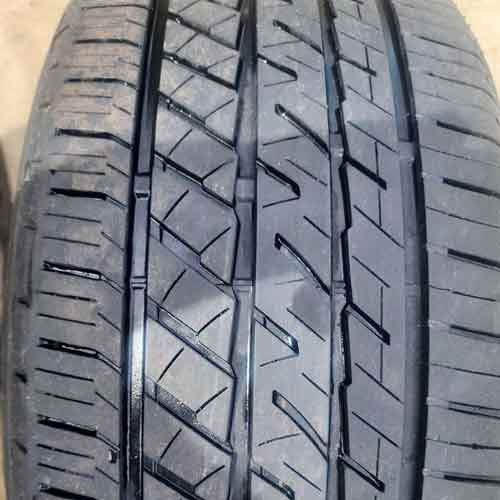Bridgestone’s DriveGuard Plus, popular for its run-flat technology, competes against the comfort-focused Turanza QuietTrack, where both boys promise reliability. But which is a better pick for you? Let’s find out.

Being a tire engineer, from my experience, both tires have their merits. While Bridgestone DriveGuard Plus excels in dry cornering and ice grip, Turanza QuietTrack shines in wet conditions and ride comfort. And yes, it offers better mileage and fuel economy as well.
Tire Sizes
The Bridgestone DriveGuard Plus comes in 16 to 19 inches wheels. And those have following specs.
- Speed ratings: H, V and W.
- Load ratings: SL and XL.
- Tread depth: 9/32″ on all.
- Weight range: 23 to 44 lbs.
- Treadwear warranty: 65k for all.
- UTQG rating: 640 A A.
On the other side, the Bridgestone Turanza QuietTrack comes in 15 to 20 inches wheels and they have the following specs.
- Speed ratings: H and V only.
- Load ratings: SL and XL.
- Tread depth: 9 to 10/32″.
- Weight range: 19 to 33 lbs.
- Treadwear warranty: 80k miles.
- UTQG rating: 800 A A.
Tire’s Construction
The Bridgestone Turanza QuietTrack comes with a symmetrical tread pattern.

Here 5 ribs (2 outer of shoulders and 3 central), form 4 circumferential grooves.
(All these grooves have a secondary pattern on them too, which basically helps the tire with snow traction and noise reduction).
And since the 3 central ribs are voided up, they interconnect with those longitudinal groove effectively.
Though still all these lugs have stability as they are sitting on reinforced foundations.
All of them have interlocking siping (changing angles from rib to rib), and chamfered edges.
The shoulder lugs on the other hand, have lateral siping, which are also interconnected with longitudinal slits.
Internally, the tire comes with single ply polyester and single ply nylon cap ply, with 2 steel belts in between.
The Bridgestone DriveGuard Plus although comes with a similar 5 rib structure, it has an asymmetrical tread pattern.

First off, this tire is more voided up, and doesn’t carry as many sipes, as seen on its counterpart.
Though it does offer a better mixture of linear and interlocking siping on both internal and outer ribs.
The 3 internal ribs, also carry in-groove notches, and have foundational supports, where they are all sitting on a secondary continuous running rubber underneath.
While moving towards outer ribs, you see shoulders which are different from each other.
Here one side displays rectilinear siping, interconnected by thick longitudinal slits.
While other side has lugs although with similar slits, but here attached to them are wave-like siping.
Internally the tire comes with two-ply polyester casing, with 2 steel belts and a nylon cap ply. Moreover its sidewalls have extra rigid construction, allowing for its run flat design.
Dry Performance
A standout dry performance is fundamental for any all-season tire. This encompasses responsive steering, proficient cornering, and effective braking.
Let’s get into each aspect.
Directional Grip
This grip is precisely as its name implies, I mean it gauges the tire’s friction with the road during linear movement, such as on highways.
And so given its directional nature, it primarily evaluates the tire’s stopping ability. This is largely determined by the tire’s central region, which basically gets the most of the vehicle’s weight as it rolls straight.
Now comparing both tires here, one can explain why both of them have similar braking efficacy, as seen by their same stopping distances (on average).
That’s because both tires have ribs fortified by reinforced foundations, and that offers impressive stability, enhancing the on-center feel.
Moreover, their chamfered edges on lugs, prevent them from pressing against each other during deceleration, ensuring smoother braking.
And yes, while the interlocking siping on the lugs is primarily for wet grip, they also act as biters on these both tires too, adding to their overall longitudinal traction.
Dry Cornering Grip
Where straight line grip depends on central lugs, the lateral grip of a tire is dependent on shoulders, and that’s because of the centripetal force, let me explain.
When a tire undergoes a turn, the inherent weight of the tire resists this change, resulting in a concentration of force on the shoulders or the tread’s edges. So with shoulder making the most contact with the road, they become crucial for determining the overall lateral grip.
In this regard, the Bridgestone DriveGuard Plus is taking the lead. And that’s mainly due to its slightly better steering response comparatively.
Although the tire is heavier, it still benefits from its stiffer sidewalls and a shallower tread depth.
These features result in lugs that are less susceptible to flexing. This is key because lug flexing necessitates additional time for the tread to regain its shape, impacting overall handling times.
So you get a more satisfying steering here.
Tread Life
For a tire to have an impressive tread lifespan, it needs to combine a sturdy build with cutting-edge design elements. Such tires employ stiffer rubber to ward off wear while maintaining a solid grip across varied conditions.
Now among all-season tires, the Bridgestone Turanza QuietTrack stands out impressively in terms of its tread longevity, which is backed up by its 80k miles in treadwear warranty.
Thanks to its single-ply polyester carcass and a singular nylon cap ply, the tire is pretty light in weight.
This reduced weight exerts less pressure on the tire lugs when they interact with the road, which in turn contributes to the tire’s prolonged tread life.
Furthermore, it has a more profound tread depth comparatively. So, it takes longer to reach down to the 2/32″ replacement benchmark.
On the other side, the DriveGuard Plus is although not so bad, it still lacks compared to its counterpart, as one can clearly see, comparing their respective Uniform Tire Quality Grading (UTQG) ratings.
So the DriveGuard Plus, rated at 640, shows that it would last approximately 6 to 7 times longer than a reference tire. In contrast, the Turanza QuietTrack, with a UTQG of 800, outlasts the reference tire by about 8 times, showing its longer tread life.
Wet Performance
Achieving superior wet grip hinges on two essential elements: abundant siping and ample tread flexibility.
But why are these two so important here?
Sipes function at a microscopic level, clearing water incrementally. They flex, creating a negative pressure that draws in water particles. And so, without adequate flexibility, sipes can’t efficiently wick away these water molecules.
This is where the Bridgestone DriveGuard Plus falls short. Although it comes with detailed sipes with full depth structures, positioned at diverse angles all over the tread, its overall wet grip remains unimpressive, because of it’s tread’s rigidity.
So they don’t allow these sipes to soak up as much water, in comparison.
Conversely, the Bridgestone Turanza QuietTrack, composed of a softer compound and a blend of linear and interlocking siping, excels here.
Moreover, the tire also has another advantage of being more voided up, offering enhanced hydroplaning resistance.
By effectively channeling more water through its grooves, it reduces the load on the sipes, further boosting its wet traction.
Fuel Consumption
Delving into fuel consumption, it’s clear that rolling resistance is a crucial determinant. And this resistance is directly proportional to the tire’s weight and its grip.
In this context, the Bridgestone DriveGuard Plus lacks, mainly because of its heavier construction, and more in number wave-like siping.
The added weight means the tire lugs experience increased pressure when they make contact with the road, resulting in heightened friction.
While extra (interlocking) siping, although provides decent ice and wet grip, it also increases the friction with the road, lowering overall fuel economy for this tire.
Though given that its a run flat tire, its pretty much expected.
Ride Comfort
The Bridgestone DriveGuard Plus offers a ride akin to most conventional tires, adeptly handling minor road imperfections.
However, its run-flat structure isn’t able to handle bigger road bumps effectively. I mean the tire tends to reach its flexibility limit sooner than its peer, leading to a more noticeable vibration in the vehicle.
With additional layers on sidewalls, the tire, simply put gives a more jittery ride in comparison.
On the flip side, the Bridgestone Turanza QuietTrack, designed as a luxury performance tire, excels where it adeptly dampens out road irregularities effectively.
By effectively I mean it delivers a ride that’s both supremely plush and impeccably stable. So you get a more controlled soaking abilities on this tire, relatively.
Snow Traction
When it comes to winter performance, both tires are coming with a mixed bag of results.
Simply put, the Bridgestone DriveGuard Plus provides better ice grip, whereas the QuietTrack is superior in terms of snow traction.
Despite its somewhat harder rubber composition, (mainly form its run flat design), which struggles to adjust thermally and can become stiff in subzero temperatures, the DriveGuard Plus’s abundant siping and chamfered tread edges still allow for better ice traction (comparatively).
On the other hand, the Bridgesonte QuietTrack coming with more in-groove notches, provide biters which latch onto snow particles, creating a better snow-to-snow contact.
And given that snow bonds more effectively to itself than to rubber, this tire excels when it comes to soft snow traction.
Road Noise
When it comes to noise levels, the Bridgestone DriveGuard Plus exhibits a slightly louder profile than its counterpart.
But what’s behind this additional noise?
A significant factor is the tire’s tread design. As air particles interact with the tread, they clash with the adjacent walls, generating sound waves.
These waves, prone to echoing, bounce within the tread walls, further add to the overall noise.
Where in case of DriveGuard, you hear a subtle high-frequency tone accompanied by a muted hum. While this noise is relatively low, it’s more discernible when benchmarked against its competitor here.
Speaking of which, the Bridgestone Turanza with its QUIETTRACK technology, offering a variable pitch tread and incorporating polymers offers a much more quieter ride.
The variable pitch design means that air particles engage different tread sections, producing diverse sound frequencies that counteract one another.
While the integrated polymers absorb these sound waves, significantly reducing in-tread resonance.
To Sum Up
Although both tires have their strengths and weaknesses, each brings unique attributes to the table.
The Bridgestone DriveGuard Plus excels in certain areas like dry cornering and ice traction, making it suitable for specific conditions and preferences.
On the other hand, the Turanza QuietTrack, with its superior wet performance, tread life, and ride comfort, positions itself as a top contender in its category.
So overall, the right choice between these two depends on your specific needs, whether you prioritize performance, longevity, comfort, or a mix of these factors.
I was excited to read about the turanza quiettrack but disappointed that it doesn’t come in my size. 235/55R19. I wonder what is the quietest tires I could put on my 2021 Honda CRV hybrid touring?
According to my tests, the Pirelli Cinturato All Season SF2 is actually the quietest tire. I actually also added it in my list of top grand touring tires too.